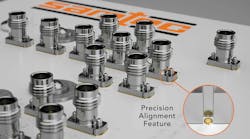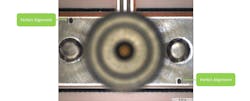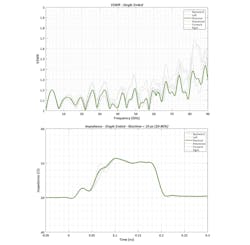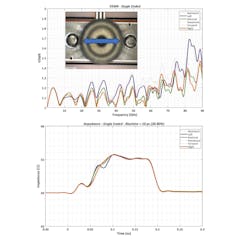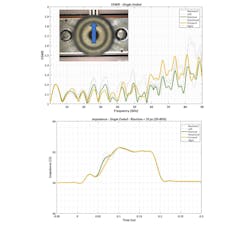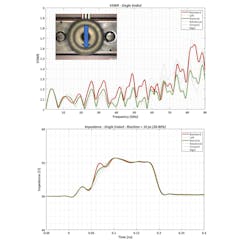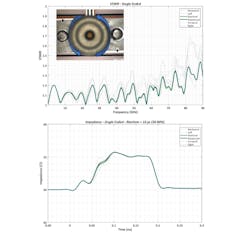This article is part of the TechXchange: Interconnect Insights.
Members can download this article in PDF format.
What you’ll learn:
- How compression-mount connectors are being used in RF and microwave designs.
- Why connector alignment matters.
- How to speed up assembly, alignment, and yield when using compression-mount connectors.
Interconnect density continues to intensify in the latest millimeter-wave (mmWave) designs, and as such, manufacturing variations can noticeably impact performance at high frequencies. To conserve PCB real estate, designers are increasingly turning to small compression-mount connectors, particularly in test, prototype, and diagnostic applications. One concern with these types of connectors is the risk of misalignment. Unfortunately, it has historically been difficult to detect.
This article explains how compression-mount connectors are used in RF and microwave systems and why alignment is so important, and then examines the impact of misalignment on performance. The work detailed here shows that a visual indicator of proper alignment can greatly speed up assembly, alignment, and yield in designs using small compression-mount connectors.
The Advantages of Compression-Mount Connectors
In today’s wireless designs, it’s necessary to scrutinize the performance of even the smallest components. Many mmWave designs, particularly for communication and sensing technologies, incorporate precision, high-frequency test connectors that handle frequencies of 90 GHz or higher. To capture nonlinear and harmonic performance, these components are frequently tested at many times their maximum operating frequency.
Threaded, coaxial compression connectors are growing in popularity for high-precision mmWave interconnect, largely due to their ease of use, reusability, repeatability, and performance. Compression connectors are much like soldered coaxial connectors, except that the center conductor and ground connections are made through precision-designed compression contacts. Rather than being soldered, these connectors employ mounting screws for fixturing and alignment. Because the design requires only mounting holes on the PCB, they can be used and reused on traces anywhere.
Higher-density interconnects require tighter tolerances for connector placement. As a result, proper positioning becomes even more important to ensure reliable, repeatable, high-precision connections between the transmission lines and test leads of the high-frequency test equipment.
Why Alignment Matters for Interconnects
Compression-mount connectors come in a range of sizes, which also means a variety of footprints. Some of the smallest 1.35-mm connectors have a tiny center-pin diameter of 254 µm. Because the trace widths on the landing pads are approximately the same diameter as the center pin, there’s significant potential for misalignment at these small sizes.
A compression-mount connector can become misaligned in multiple ways, including rotational, lateral, forward, and backward.1 The analysis performed in this article uses Samtec’s compression-mount RF connectors with visual alignment guides machined into the base of the connector housing to assess the impact of misalignment. In this study, performance degraded for each type of misalignment, except for rotational. This doesn’t exclude the possibility that rotational alignment can’t degrade performance; further study may reveal use cases where there’s an impact.
The best way to understand the performance costs of misalignment is through comparison with a well-aligned connector (Fig. 1). Samtec’s threaded compression-mount connectors have visual alignment guides machined into the base of the connector housing. This approach enables visual indication of compression connector’s alignment/misalignment in reference to the surface metal layer of the PCB.
The PCB fiducials can be specifically designed for the connector alignment guides. This provides visual assurance that the connector center pin and recess for the planar transmission-line trace are aligned with the PCB landing pad (or, in the case of this analysis, will confirm that the center pin is misaligned).
In Figure 2, the green trace shows the measured voltage standing-wave ratio (VSWR) and impedance performance of a well-aligned connector (as shown in Figure 1, where both fiducials are fully visible and entirely contained within the fiducial cutouts). These measured performance curves will be used for comparison with misaligned connectors later in this article.
Impact of Misalignment on Connector Performance and VSWR
In lateral misalignment, the connector is off-center in a side-to-side orientation, and both fiducials will be slightly covered by the fiducial cutout, indicating poor alignment. Figure 3 shows the VSWR and impedance performance of left (purple trace) and right (orange trace) lateral misalignment as compared to nominal (green trace).
Lateral misalignment to either side degrades VSWR performance. In this example, one side may be performing worse than the other due to asymmetric PCB mis-registrations, such as tolerance of the hardware drill placement. In terms of impedance, there’s some noticeable changes versus nominal. For applications where de-embedding is required, this amount of degradation in VSWR performance could be critical.
In cases of forward misalignment, the rear fiducial protrudes from the fiducial cutout (Fig. 4). Backward misalignment is shown in Figure 5. Measured results show a significant impact on VSWR for forward or backward misalignment, which would lead to degraded connector performance. Like lateral misalignment cases, these types of degradations can significantly affect performance and measurements, particularly as frequencies reach 56 GHz and above.
Probably not surprising, the misalignment with the least impact on performance in this study was rotational misalignment. In this case, neither fiducial is entirely within the fiducial cutout. VSWR performance is only slightly degraded, and there’s a minimal difference in impedance (Fig. 6).
This study showed that a loss in performance occurs for all types of misalignments except for rotational. Forward and backward misalignment demonstrated the largest performance degradation. Unfortunately, this is the most challenging type of misalignment to visually determine in compression-mount connectors that don’t have fiducial cutouts.
Misalignment’s Effects on PCB Yield and Assembly
Alignment matters because it may have a dramatic effect on yield, and, because it has historically been hard to determine, troubleshooting can be time-consuming. Before the development of alignment grooves on compression-mount connectors paired with fiducials on a PCB, the methods to ensure alignment were unreliable. For example, the most common method depended on the screws used to fixture the compression connector to the RF board to ensure alignment. However, it’s possible that the “play” between the two screws could allow for undesirable movement of the coaxial connector.2
Without fiducials, the perimeter of the outer housing is the only feature on compression connectors suitable for performing a visual indication of alignment. While some flat surfaces typically exist on the outer housing of these connectors, they’re not necessarily machined to the same level of tolerances as the internal features of the coaxial conductors and could prove to be an unreliable method of confirming alignment.
Another common method for avoiding misalignment was to insert alignment pins through a feature on the compression connector body and the PCB. This approach increased the complexity of indexing the PCB during the manufacturing process.3
In both methods, relying on a technician to assemble the tiny connectors and notice slight misalignments in relation to screws or pins was difficult. As a result, misalignments typically became apparent during the electrical testing stage. Here, the challenges of troubleshooting could be considerable as they would consider interconnect issues in the other RF hardware, transmission-line defects, and PCB issues.
Fiducials Improve Alignment of Compression-Mount Connectors
Fortunately, alignment grooves on the compression-mount connector combined with fiducials on the PCB can be used to reliably achieve alignment in small-form-factor mmWave connectors. Precisely machined alignment grooves in opposite sides of the base of the compression-mount connector provide a very clear, visual indication of alignment (Fig. 7).
These guides are located as close to the connector body as possible and readily visible during assembly. They’re also close to the PCB surface to minimize any confusion due to perspective.
Conclusion
Proper alignment of compression-mount connectors can be critical to performance. Manufacturers using compression-mount RF connectors need to seriously consider the impact of misalignment because it introduces impedance discontinuities, which increases reflections and degrades VSWR performance.
A visual indicator of proper alignment can greatly speed up assembly, alignment, and yield in designs using small compression-mount connectors, because it avoids costly troubleshooting later in the manufacturing process. This article shows the impact of misalignment, and how it can be avoided with alignment grooves on the connector and fiducials on the PCB.
Read more articles in the TechXchange: Interconnect Insights.
References
1. Millimeter wave design: Optimizing Performance in RF Compression Mount Connectors, Samtec White Paper, July 2023.
2. Mechanical Consideration for Compression Mount RF Connectors, Samtec gEEk® spEEk, December 2022
3. How to Reliably Align Compression Connectors for Millimeter Wave Applications, Jean-Jacque DeLisle, Microwave Journal, March 2023.
